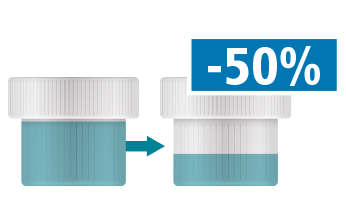You’ve probably barely noticed the change, but if you’re of a certain age you might just remember the days of big boxes of laundry powder. No more. Today, you get many more washloads out of a smaller pack.
In the past 20 years (1997-2017), the industry has worked hard to minimise the average dose of laundry detergent needed massively, through a combination of new, more concentrated and high-performance ingredients and helping everyone to understand that you can use less and still get just as great results.
In fact, the average dosage is now half what it used to be, which means we’re using about 3 million tonnes a year less laundry detergents in Europe today than we were 20 years ago, even though there are more households and more washes being done.
More compact means less environmental impact
More compact detergents means less packaging is needed and products take up less space, so less transport is needed too and CO2 emissions are saved as a result.

Meanwhile, performance is just as good as, or better than, previous less concentrated products, thanks to more sophisticated high performance ingredients that work well in low concentrations.
With detergent compaction, the amount of active chemistry per wash remains the same or may even be reduced thanks to technological innovation. Hence in terms of environmental safety, compacted detergents are equivalent or better than their less compact predecessors.
How you can help
You can help achieve these environmental savings – and save money – by choosing compact detergents and then making sure you dose them correctly, so you don’t use too much.
All laundry detergents have a wash basket symbol  on them that shows how many washes you can do per package, to make it easier for you to see how much you are paying for each washload and make a sustainable choice. Follow also the dosage guidance provided on the back of pack by the manufacturer.
on them that shows how many washes you can do per package, to make it easier for you to see how much you are paying for each washload and make a sustainable choice. Follow also the dosage guidance provided on the back of pack by the manufacturer.
You can also find on most packs a panel with tips for saving water, energy, CO2 and money.
